Presentation - Copernicus.org
advertisement
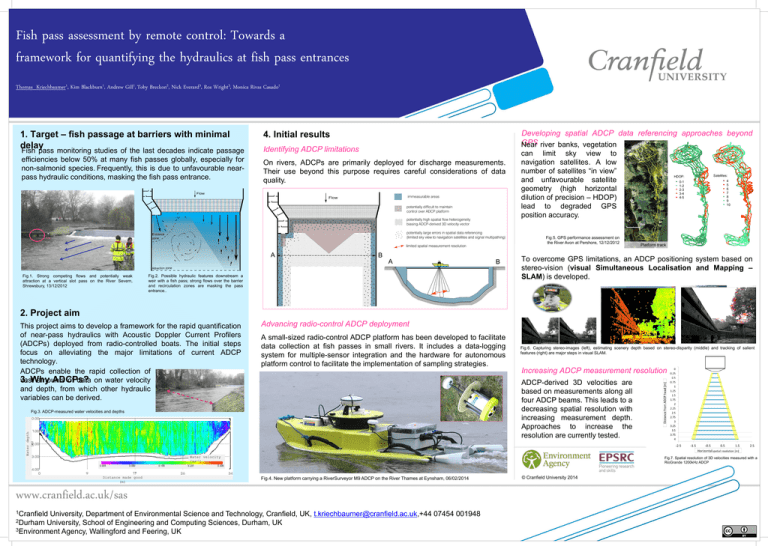
Fish pass assessment by remote control: Towards a framework for quantifying the hydraulics at fish pass entrances Thomas Kriechbaumer1, Kim Blackburn1, Andrew Gill1, Toby Breckon2, Nick Everard3, Ros Wright3, Monica Rivas Casado1 1. Target – fish passage at barriers with minimal delay Fish pass monitoring studies of the last decades indicate passage efficiencies below 50% at many fish passes globally, especially for non-salmonid species. Frequently, this is due to unfavourable nearpass hydraulic conditions, masking the fish pass entrance. 4. Initial results Identifying ADCP limitations On rivers, ADCPs are primarily deployed for discharge measurements. Their use beyond this purpose requires careful considerations of data quality. Developing spatial ADCP data referencing approaches beyond GPS river banks, vegetation Near can limit sky view to navigation satellites. A low number of satellites “in view” and unfavourable satellite geometry (high horizontal dilution of precision – HDOP) lead to degraded GPS position accuracy. HDOP: 0-1 1-2 2-3 3-4 4-5 Satellites: 4 5 6 7 8 9 10 20m Fig.5. GPS performance assessment on the River Avon at Pershore, 12/12/2012 Fig.1. Strong competing flows and potentially weak attraction at a vertical slot pass on the River Severn, Shrewsbury, 13/12/2012 Platform track To overcome GPS limitations, an ADCP positioning system based on stereo-vision (visual Simultaneous Localisation and Mapping – SLAM) is developed. Fig.2. Possible hydraulic features downstream a weir with a fish pass; strong flows over the barrier and recirculation zones are masking the pass entrance.. 2. Project aim This project aims to develop a framework for the rapid quantification of near-pass hydraulics with Acoustic Doppler Current Profilers (ADCPs) deployed from radio-controlled boats. The initial steps focus on alleviating the major limitations of current ADCP technology. ADCPs enable the rapid collection of 3. ADCPs? vastWhy amounts of data on water velocity and depth, from which other hydraulic variables can be derived. Advancing radio-control ADCP deployment A small-sized radio-control ADCP platform has been developed to facilitate data collection at fish passes in small rivers. It includes a data-logging system for multiple-sensor integration and the hardware for autonomous platform control to facilitate the implementation of sampling strategies. Water depth [m) Increasing ADCP measurement resolution ADCP-derived 3D velocities are based on measurements along all four ADCP beams. This leads to a decreasing spatial resolution with a) increasing measurement depth. Approaches to increase the resolution are currently tested. Fig.3. ADCP-measured water velocities and depths Water velocity [ms-1] Distance made good (m) Fig.7. Spatial resolution of 3D velocities measured with a RioGrande 1200kHz ADCP Fig.4. New platform carrying a RiverSurveyor M9 ADCP on the River Thames at Eynsham, 06/02/2014 www.cranfield.ac.uk/sas 1Cranfield Fig.6. Capturing stereo-images (left), estimating scenery depth based on stereo-disparity (middle) and tracking of salient features (right) are major steps in visual SLAM. University, Department of Environmental Science and Technology, Cranfield, UK, t.kriechbaumer@cranfield.ac.uk,+44 07454 001948 2Durham University, School of Engineering and Computing Sciences, Durham, UK 3Environment Agency, Wallingford and Feering, UK © Cranfield University 2014
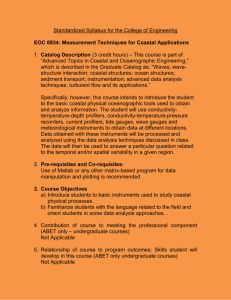
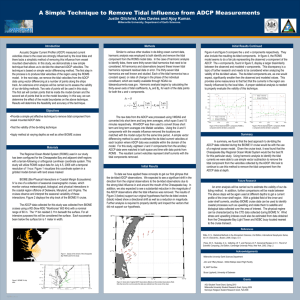
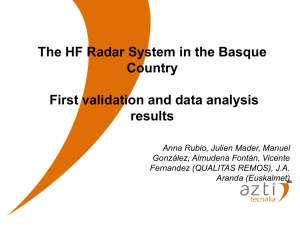
![RV_Samudrika_OCD[1] - National Aquatic Resources](http://s3.studylib.net/store/data/006800414_1-43b0de77fff9015425fb10ff885be924-300x300.png)

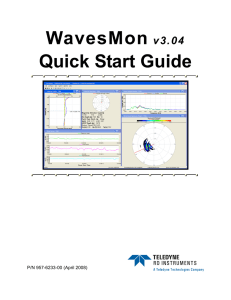
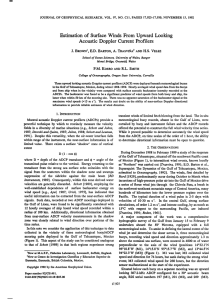


![RV_Samudrika_OCD[1] - National Aquatic Resources](http://s3.studylib.net/store/data/006968597_1-c581bfc34257e9ab61fd82238f7d082d-300x300.png)

